Beef bulgogi rice bowls are a delicious and satisfying meal that is easy to prepare and perfect for a quick and healthy lunch or dinner. The dish features tender slices of marinated beef bulgogi, served over a bed of fluffy rice and topped with stir-fried baby bok choy, green onions, sesame seeds and a tahini-soy sauce.
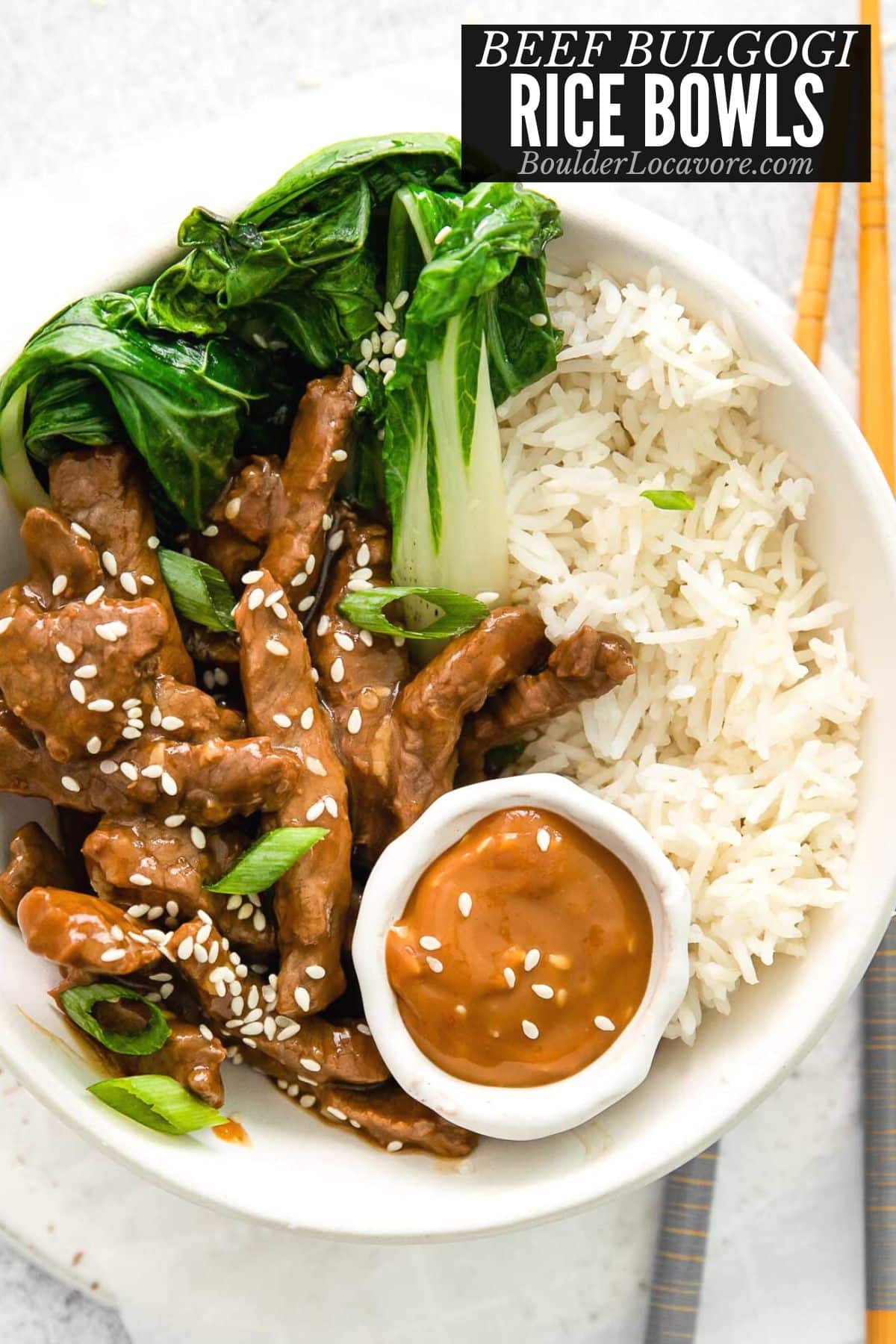
The combination of savory beef, nutty rice, and crunchy vegetables creates a perfect balance of flavors and textures in every bite. Beef bulgogi rice bowls are not only delicious, but they are also a nutritious and well-balanced meal, packed with protein, fiber, and essential vitamins and minerals.
With its bold flavors and simple preparation, beef bulgogi rice bowls are a crowd-pleasing dish that is sure to become a staple in your meal rotation.
We’ve paired traditional flavors and preparation with an original tahini-soy delicious sauce to bring even more flavor to this well-loved Korean bulgogi beef dish.
Jump to:
What is Beef Bulgogi?
Beef bulgogi is a Korean dish made with thinly sliced beef that is marinated in a mixture of soy sauce, sugar, garlic, sesame oil, and other seasonings, then grilled, pan-fried, or stir-fried. The marinade infuses the beef with a sweet and savory flavor and tenderizes the meat.
Bulgogi” (불고기) is a Korean word that literally means “fire meat”.
Beef bulgogi is often served with rice, lettuce leaves, and other side dishes such as kimchi, and is a popular dish in Korean cuisine. We’ve transformed ours into a satisfying rice bowl that’s hearty and filling.
Ingredients Notes
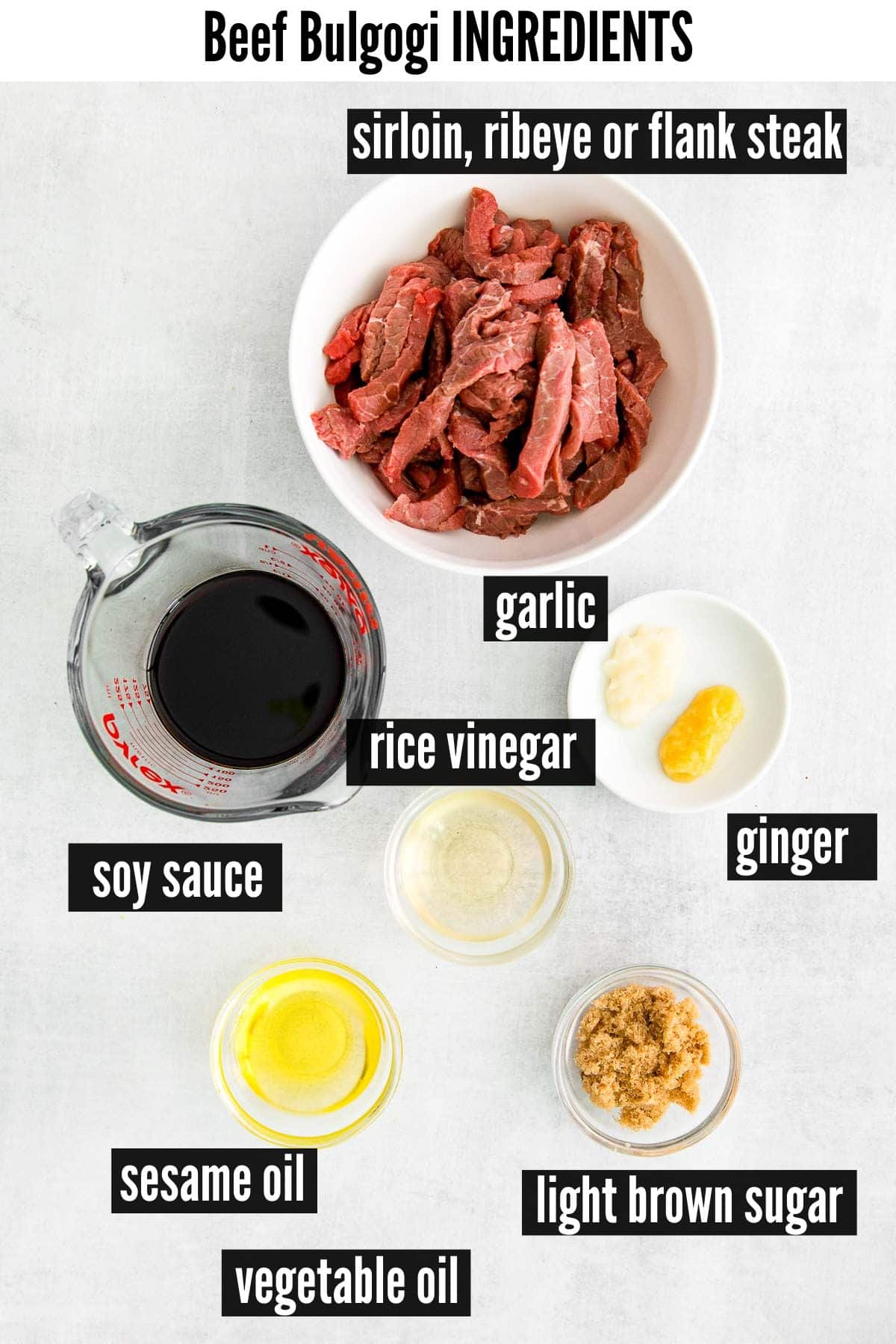
- 1 pound thinly sliced beef. We used sirloin which is more affordable but there are several types of beef that work. Use a sharp knife to slice thinly or have the store butcher cut thin slices of beef for you. See the Pro Tips section below.
- Oil for the marinade. We recommend sesame oil for the classic flavor it gives. If needed vegetable oil can be substituted. Oil is key in marinade to transfer the flavor and moisture to the marinated meat. Vegetable oil can be substituted.
- Soy sauce. Regular soy sauce, low sodium soy sauce (for a less salty flavor) or gluten-free Tamari can be used. You’ll use it in the marinade and bowl sauce.
- Rice vinegar. This gives a nice tang to the bulgogi marinade.
- Light brown sugar. Gives the marinade a touch of sweetness.
- Grated garlic. Using freshly grated garlic gives the marinade wonderful flavor.
- Grated ginger. Peel and grate the fresh ginger.
- Oil for stir frying. The best oil to use for stir-frying is one with a high smoke point and a neutral flavor, as it can withstand high temperatures without burning or imparting any unwanted taste to the dish. See options in the Best Oil section below.
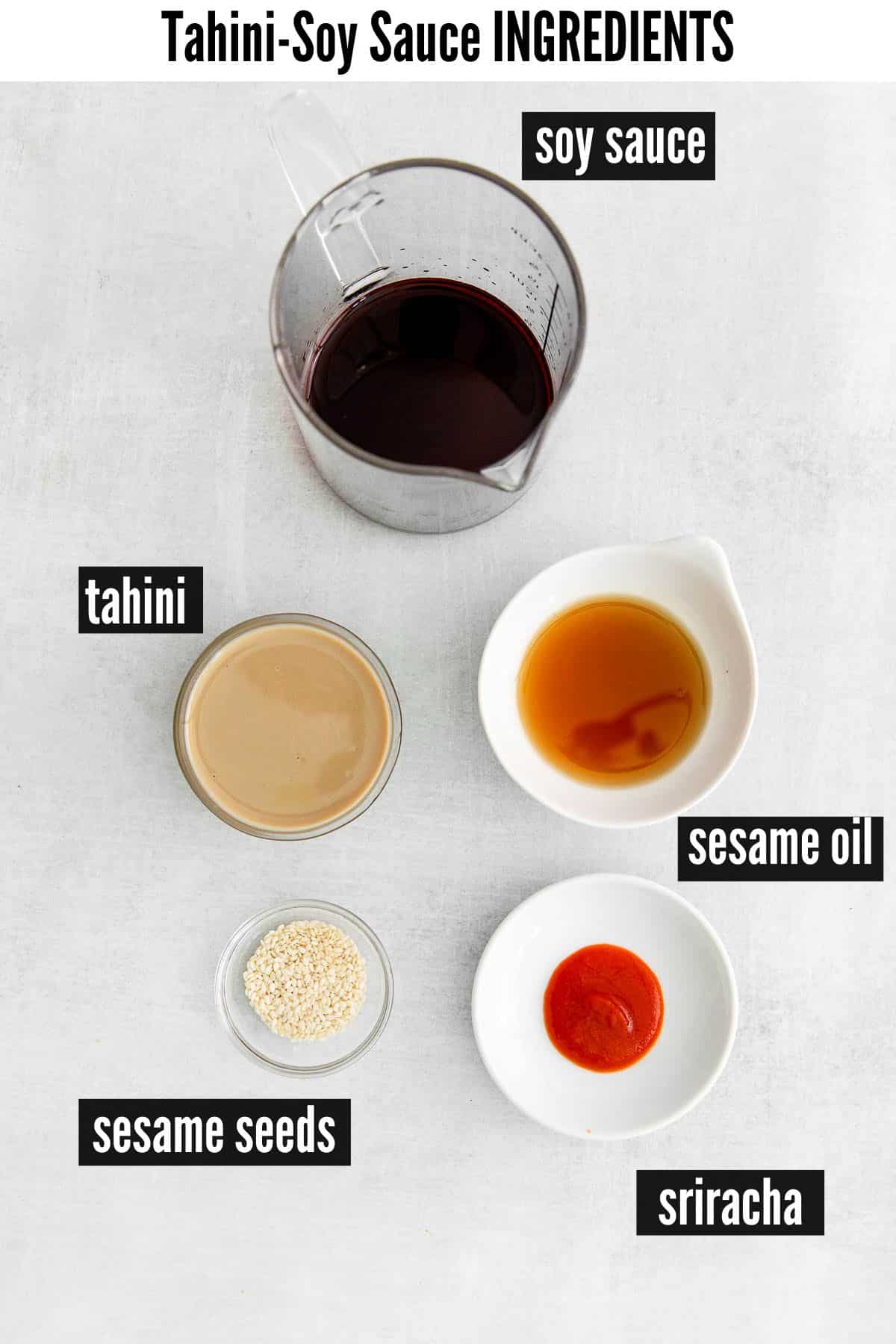
- Tahini. Tahini is a paste made from ground sesame seeds. It is a staple ingredient in Middle Eastern cuisine and is commonly used in dips, sauces, and dressings. Tahini has a nutty, rich flavor and a creamy texture, similar to nut butter. It’s obviously not traditional in Korean beef bulgogi but we love the flavor it adds to the bowl sauce.
- Sesame oil. Sesame oil has a distinct nutty and rich flavor, with a slightly sweet and savory taste that’s perfect in the bowl sauce.
- Sriracha. Gives a hint of spicy heat to the bowl sauce. If you need a substitute try one of these:
Best Sriracha Substitutes
- Hot sauce: Frank’s RedHot, Tabasco, and Cholula are all good options.
- Chili garlic paste: this is a paste made from ground chili peppers and garlic, and it has a similar spicy and savory flavor to Sriracha. You can find it in the Asian section of most grocery stores.
- Harissa: This is a North African hot sauce made from chili peppers, garlic, and other spices. It has a slightly smoky flavor and a similar level of spiciness to Sriracha.
- Red pepper flakes: If you don’t have any hot sauce or chili paste on hand, you can use red pepper flakes as a substitute. They will add heat to your dish, but won’t have the same depth of flavor as Sriracha.
- Cayenne pepper: Another good substitute for Sriracha is cayenne pepper. It has a similar level of heat, but again, won’t have the same depth of flavor as Sriracha.
NOTE: When using any of these substitutes, it’s best to start with a small amount and adjust to taste.
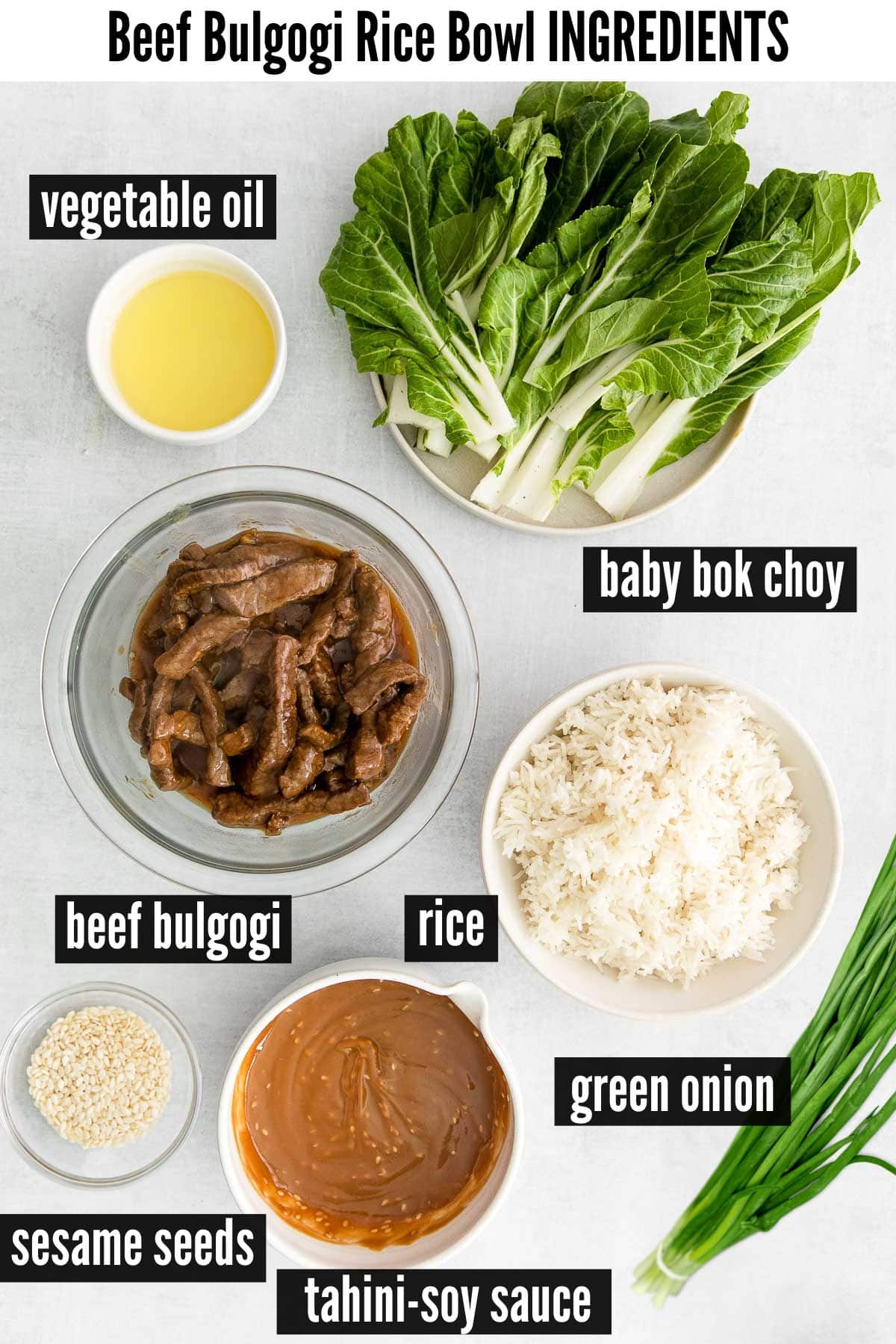
- Baby Bok Choy. This is stir fried and added to the bowls. Baby bok choy is smaller and more tender than the full grown version.
- Cooked rice. You’ll need 2 cups of cooked rice at room temperature for the bowls. White rice or brown rice can be used.
Best Oil for Stir Frying
Here are some options:
- Vegetable oil: This is a versatile oil with a high smoke point and a neutral flavor, making it a good choice for stir-frying.
- Peanut oil: This oil has a slightly nutty flavor and a high smoke point, making it ideal for stir-frying. It is also a common choice in Chinese cuisine.
- Canola oil: This oil has a mild flavor and a high smoke point, making it suitable for high-heat cooking methods like stir-frying.
- Sunflower oil: This oil has a neutral taste and a high smoke point, making it a good choice for stir-frying.
- Grapeseed oil: This oil has a light, nutty flavor and a high smoke point, making it ideal for stir-frying.
Pro Tip: When choosing an oil for stir-frying, it’s important to consider the smoke point, as using an oil with a low smoke point can result in burning and smoke. Also, make sure to use a moderate amount of oil to prevent the dish from becoming greasy.
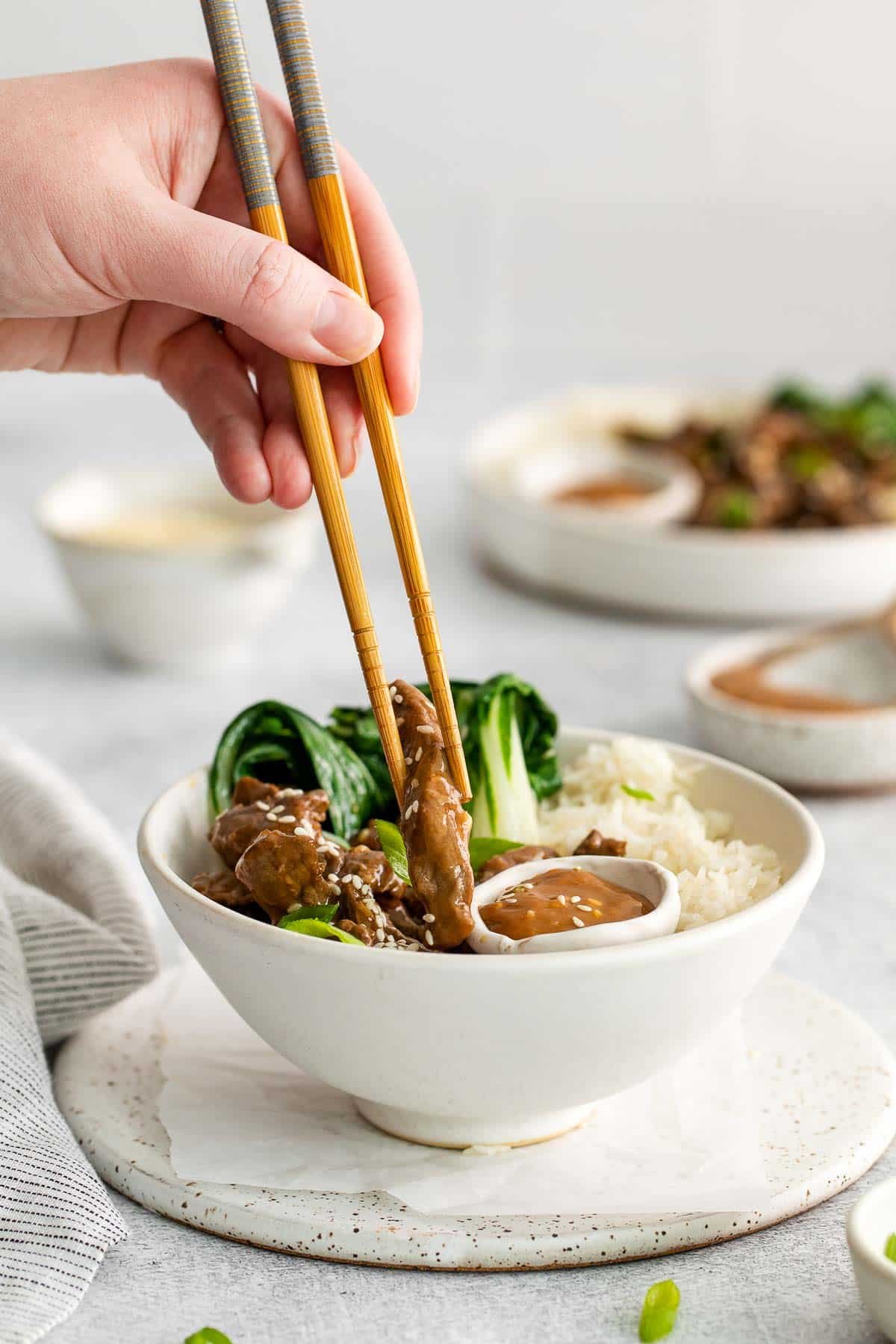
How to make it
STEP 1. Marinate
Add all of the marinade ingredients: sesame oil, beef, soy sauce, rice vinegar, brown sugar, garlic, and ginger in a large mixing bowl and mix to combine (photo 1).
Set aside at room temperature with plastic wrap on top to marinate while you prepare the sauce and rice if not yet prepared (marinate for 30 minutes or in the refrigerator overnight for more flavor).
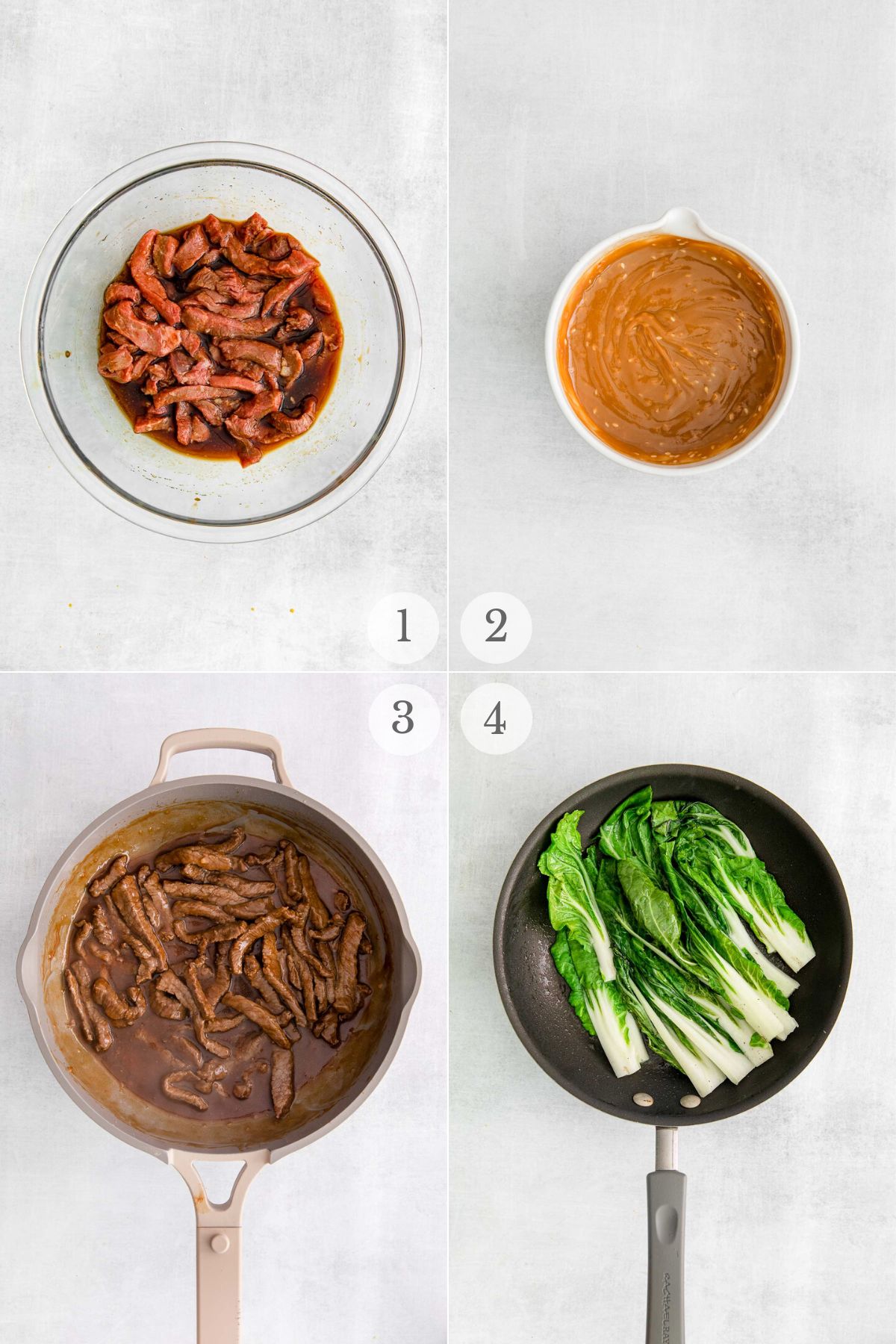
STEP 2. Make the sauce + rice
Whisk together all of the ingredients in a small bowl: tahini, soy sauce, sesame oil, sriracha and sesame seeds (photo 2). Set aside until ready to use.
If the rice has not already been prepared make it now.
STEP 3. Stir fry the beef
When the sauce and the rice are ready, heat a large non-stick skillet, cast iron skillet or wok over high heat and add the oil to the hot skillet (photo 3).
When the oil is hot, add the bulgogi (both the beef and marinade). Cook for 3-4 minutes or until the liquid has evaporated and the beef is just beginning to crisp.
When the beef is cooked to your desired doneness, remove it from the heat.
When stir-frying beef bulgogi, it is important to use high heat to get a good sear on the meat and to cook it quickly. The recommended temperature for stir-frying beef bulgogi is around 400°F (204°C) to 450°F (232°C). You can achieve this by heating up a large skillet or wok over high heat for a few minutes before adding the marinated beef. Be sure not to overcrowd the pan, as this can cause the beef to steam instead of searing. Stir-fry the beef for 3-4 minutes, or until it is browned and caramelized on the outside and cooked to your desired doneness.
STEP 4. Sauté the bok choy
Heat a small skillet over medium heat. Add the 2 tablespoons olive oil.
When the oil is hot, place the bok choy cut side down. Stir-fry for 1-2 minutes, or until they are slightly tender or until the leaves are wilted and the stalks are tender-crisp (photo 4).
STEP 5. Assemble the bowls
Evenly divide the rice between four bowls. Add the bulgogi, and boy choy on top of rice. Top with the tahini-soy sauce and garnish with green onions and sesame seeds. Enjoy.
If you want to add more Korean food inspired dishes to the meal try our Easy Korean BBQ Chicken, Korean Noodles recipe, and Sticky Korean BBQ Cauliflower.
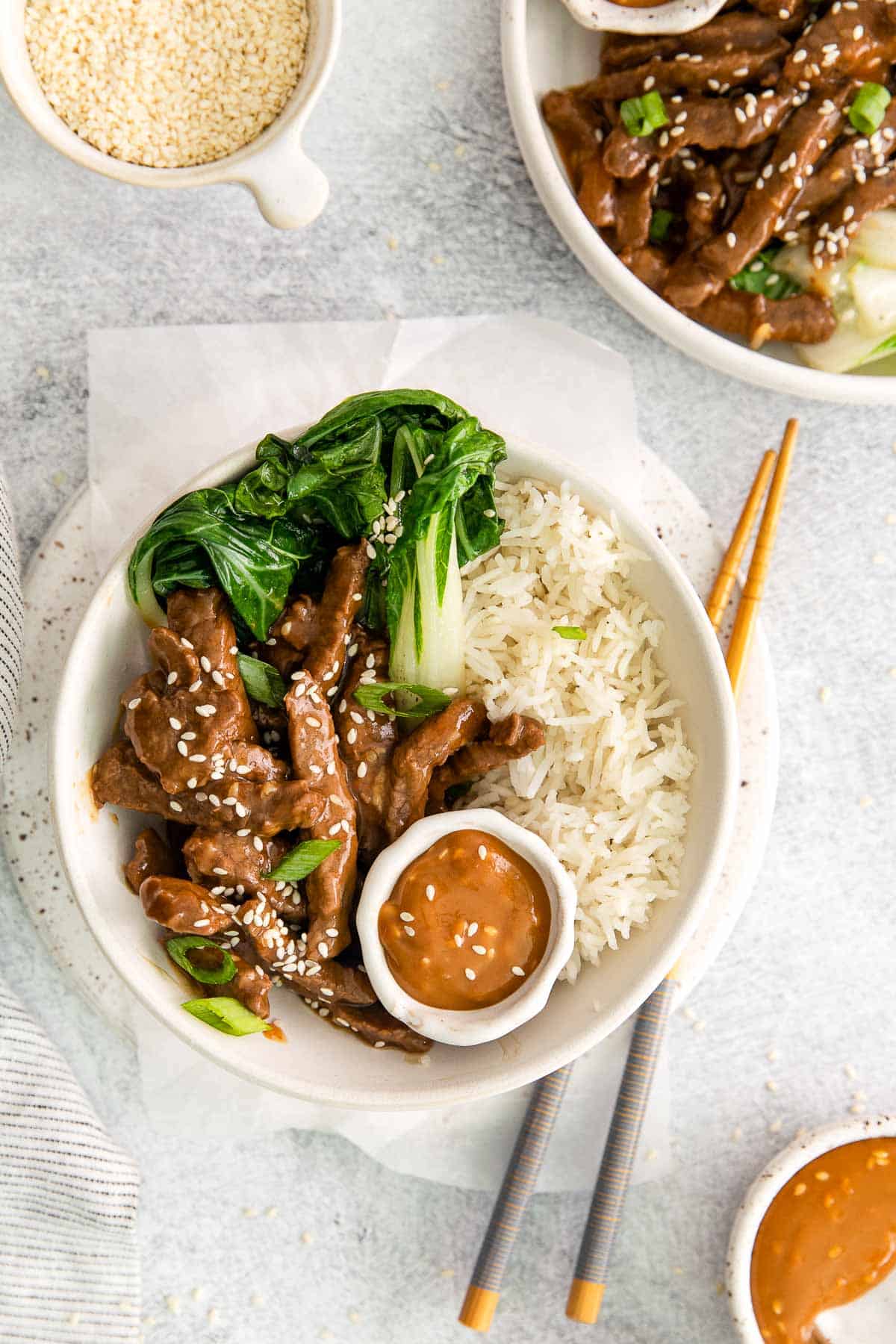
Bowl Variations
Other vegetables. If you can’t find baby bok choy or prefer a different vegetable, snow peas, broccoli, any vegetable you like will work.
Grains. We used white rice but brown rice or quinoa (more protein) would work too.
Pro Tips
- Choose the right cut of beef. For beef bulgogi, you want to choose a best cut of beef that is tender and thinly sliced. Top sirloin, rib eye, or flank steak are good choices. You can ask your butcher to slice the beef thinly for you.
- Marinate the beef for at least 30 minutes. The sweet and savory marinade is an important part of the flavor of beef bulgogi. Marinate the beef for at least 30 minutes, or overnight if possible, to allow the flavors to penetrate the meat.
- Don’t overcrowd the pan. When stir-frying the beef, make sure not to overcrowd the pan. If the pan is too crowded, the beef will steam instead of sear, and you won’t get that caramelized crust on the meat.
- Cook the beef over high heat. Beef bulgogi is best cooked over high heat to get that nice char on the meat. Use a large skillet or wok and heat it until it’s very hot before adding the beef.
- Use fresh ingredients. Make sure to use fresh garlic, ginger, green onions, and other ingredients to get the best flavor. Toast the sesame seeds just before using them for maximum flavor.
- Serve with traditional accompaniments. Beef bulgogi is traditionally served with steamed rice, lettuce leaves, and other side dishes such as kimchi and pickled vegetables. These side dishes complement the sweet and savory flavor of the beef and make for a complete meal. Feel free to add your favorites.
With these tips, you’ll be able to make delicious beef bulgogi that’s sure to impress!
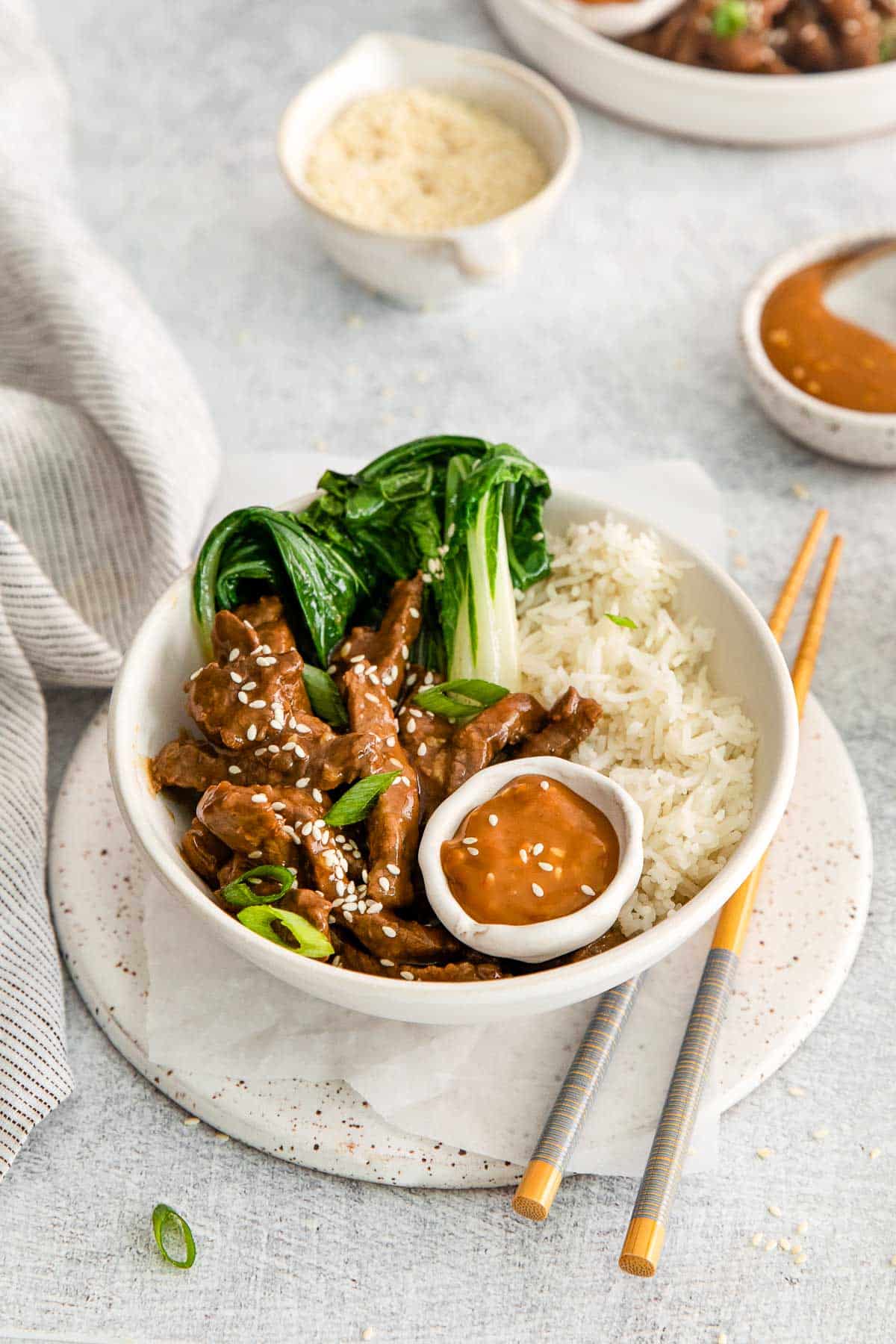
How to store leftovers
Allow the beef to cool completely. Store the leftover beef bulgogi in the refrigerator for up to 3-4 days in an airtight container. If you want to store it for longer, you can freeze it in a freezer-safe container for up to 2-3 months.
When reheating, it is best to use a microwave or a skillet over medium heat until the beef is heated through. Avoid overcooking the beef to prevent it from becoming tough and dry.
More recipes you’ll love!
Recipe
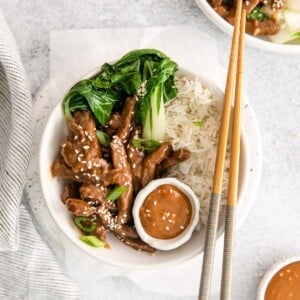
Beef Bulgogi Rice Bowls
Ingredients
For the Bulgogi
- 1 pound thinly sliced beef see Notes
- ⅓ cup soy sauce regular, low sodium or gluten-free Tamari may be used
- 2 tablespoons rice vinegar
- 2 tablespoons light brown sugar
- 1 teaspoon grated garlic
- 1 teaspoon grated ginger
- 2 tablespoons sesame oil
- 2 tablespoons oil for stir frying see Notes
For the Tahini-Soy Sauce
- ¼ cup tahini
- ¼ cup soy sauce
- 2 tablespoons sesame oil
- 1 teaspoon sriracha
- 1 teaspoon sesame seeds
Stir fry baby bok choy
- 2 tablespoons oil for stir frying see Notes
- 1 pound baby bok choy halved
For the bowls
- 2 cups cooked white rice warm or at room temperature
- 1/4 cup sliced scallions (green onions)
- sesame seeds for sprinkling
Instructions
- Combine all of the ingredients in a large bowl and mix to combine. Set aside at room temperature to marinate while you prepare the sauce and rice (about 30 minutes).1 pound thinly sliced beef, ⅓ cup soy sauce, 2 tablespoons rice vinegar, 2 tablespoons light brown sugar, 1 teaspoon grated garlic, 1 teaspoon grated ginger, 2 tablespoons sesame oil
- While the beef is marinating, whisk together all of the sauce ingredients in a small bowl. Set aside until ready to use.¼ cup tahini, ¼ cup soy sauce, 2 tablespoons sesame oil, 1 teaspoon sriracha, 1 teaspoon sesame seeds
- When the beef has completed marinating heat a large non-stick skillet, cast iron skillet or wok over high heat and add the oil.2 tablespoons oil for stir frying
- When the oil is hot (you'll see rippling on the surface), add the both the beef and marinade. Cook for 3-4 minutes or until the liquid has evaporated and the beef is just beginning to crisp.
- When the beef is cooked to your desired doneness, remove it from the heat.
Stir fry the baby bok choy
- Heat a small non-stick skillet over high heat add the olive oil (note if desired the bulgogi skillet can also be used).2 tablespoons oil for stir frying, 1 pound baby bok choy
- When the oil is hot, stir-fry for 1-2 minutes, or until they are slightly tender or until the leaves are wilted and the stalks are tender-crisp.
Assemble the bowls
- Divide the rice evenly between four serving bowls. Add the bulgogi, and boy choy on top of the rice. Top with the tahini-soy sauce and garnish with green onions and sesame seeds. Enjoy.2 cups cooked white rice, 1/4 cup sliced scallions (green onions), sesame seeds for sprinkling
Notes
-
Vegetable oil: This is a versatile oil with a high smoke point and a neutral flavor, making it a good choice for stir-frying.
-
Peanut oil: This oil has a slightly nutty flavor and a high smoke point, making it ideal for stir-frying. It is also a common choice in Chinese cuisine.
-
Canola oil: This oil has a mild flavor and a high smoke point, making it suitable for high-heat cooking methods like stir-frying.
-
Sunflower oil: This oil has a neutral taste and a high smoke point, making it a good choice for stir-frying.
-
Grapeseed oil: This oil has a light, nutty flavor and a high smoke point, making it ideal for stir-frying.
-
Pro Tip: When choosing an oil for stir-frying, it’s important to consider the smoke point, as using an oil with a low smoke point can result in burning and smoke. Also, make sure to use a moderate amount of oil to prevent the dish from becoming greasy.





Sharina says
I super love this Korean Rice Bowl! It is incredibly delicious and filling especially when served with kimchi 😍